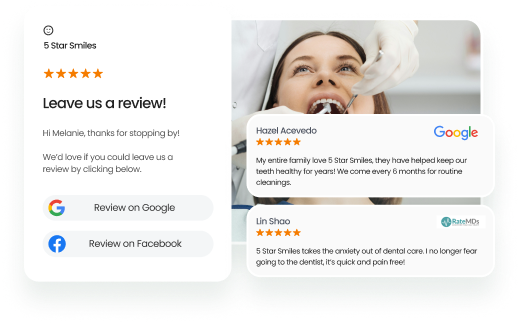Healthcare marketing trends are changing rapidly. Driven by changes in care delivery, technological advancements, and shifting patient expectations, healthcare professionals and organizations must rethink how to connect with their audiences.
In 2026, healthcare marketing’s role is no longer just about promotion—it’s about delivering relevance, building trust, and guiding patients through increasingly digital and personalized healthcare journeys.
This post outlines the top marketing trends in healthcare shaping the healthcare industry in 2026. From AI-powered tools to the growing influence of patient online reviews, each section highlights what’s changing and what it means for healthcare marketers aiming to reach patients more effectively.
Table of contents
- The shifting healthcare market: what marketers need to know
- Data and AI are redefining patient engagement
- Local focus, global tools: digital marketing priorities
- Content, conversation, and credibility
- Channels to watch: where attention is moving
- Virtual, augmented, and automated: the tech behind the message
- Staying compliant while staying connected
- Final thoughts
- Frequently asked questions on healthcare marketing trends
- Birdeye for healthcare: reputation, visibility, and engagement—powered by AI
The shifting healthcare market: what marketers need to know
Marketing strategies don’t exist in a vacuum. Every shift in payer models, care settings, and patient needs affects how outreach should be planned and delivered. Below are four key market dynamics that are reshaping how care is accessed, chosen, and experienced.
- More patients are returning to care—marketers should be ready to reconnect
Many people postponed doctor visits, screenings, and treatments in the past few years—especially during the pandemic. Now, in 2026, things are turning around. Outpatient services (like physiotherapy, diagnostics, and minor procedures) and behavioral health (like therapy and counseling) are seeing more patient demand again.
This means healthcare marketers have a great opportunity to reconnect with people who delayed care. You can do this by:
- Updating your marketing content to reflect services that are now back or in higher demand.
- Running campaigns that remind patients it’s safe and easy to return.
- Promoting convenient booking options, available appointments, and follow-up care.
In short, patients are coming back—but you need to remind them why they should choose your practice or service.
- Changing insurance coverage shapes patient outreach
As insurance coverage shifts through expanding government programs and evolving employer plans, outreach must connect with a broader patient base. Insurance status heavily influences care decisions; A recent survey shows that 62% of patients have delayed care due to coverage issues, and 43% report worsened health as a result.
Healthcare marketers must ensure clear messaging around affordability, access, and coverage options. Campaigns that clarify what’s covered, highlight financial assistance, or promote transparent pricing can build trust and drive engagement.
- Non-hospital growth opens new marketing channels
Care is increasingly shifting from hospitals to outpatient clinics, urgent care centers, and home-based services. As per recent market research by the CMI Team, the global outpatient care market is expected to grow at a CAGR of 12.1% from 2023 to 2032.
This shift allows healthcare marketers to highlight new messaging angles: flexible scheduling, short wait times, walk-in availability, and neighborhood-based care. Hyperlocal campaigns, location-specific promotions, and service-line personalization (e.g., “urgent care near you” or “same-day home visits”) can resonate with patients who value speed, simplicity, and comfort.
- Provider-level branding is becoming more important
Patients are increasingly choosing individual doctors over healthcare brands, focusing on physicians’ credentials, personalities, and patient feedback. Highlighting a doctor’s expertise, compassionate care, and positive reviews can significantly build trust and influence patient decisions.
Using video, testimonials, and social proof can humanize providers and build the trust that drives appointment bookings. This way, provider-level branding is now a key strategy for healthcare organizations aiming to attract and retain patients.
Data and AI are redefining patient engagement
Artificial intelligence is changing how healthcare professionals and organizations gather insights and deliver relevant messages. When used responsibly, these tools improve providers’ understanding and service of patients. Here’s how:
- Predictive analytics for patient behavior
AI can spot patterns like delayed follow-ups or or dropped-off communications to identify when a patient may be at risk of disengaging. For example, if a system detects that no-show rates are rising for a particular service or demographic, marketing teams can proactively send reminders or adjust messaging to re-engage patients before gaps widen.
This type of early intervention supports better patient outcomes while also improving marketing efficiency and reducing churn.
- Personalized campaigns through AI-powered insights
Campaigns that reflect a patient’s history, needs, or location perform better. With the help of AI, it’s now possible to deliver that level of personalization at scale. For instance,
- An AI system could send a reminder to a diabetic patient about their upcoming screening based on their treatment history
- It can alert a patient about flu shots in the fall based on their health history.
Smarter segmentation and relevant timing can improve engagement without adding complexity. AI tools can segment patients based on factors like age or medical history, so a patient who recently had a heart procedure could receive targeted follow-up care reminders.
- Privacy-first personalization strategies
Even as tools become more advanced, privacy remains a core expectation. Responsible personalization means using consented data, following HIPAA requirements, and maintaining patient trust.
Clear opt-in processes, easy unsubscribe options, and transparency around data use can strengthen trust and lead to better long-term engagement. This way, campaigns that balance relevance with transparency are more likely to build long-term loyalty.
Local focus, global tools: digital marketing priorities
Patients may have access to global healthcare information, but healthcare decisions remain local. Marketing should reflect that local-first mindset while using tools that scale.
- Local SEO remains mission-critical
When a patient searches “dentist near me” or “urgent care open now,” a well-optimized local or Google Business Profile ensures your practice shows up. Updating hours, services, and contact information can make the difference between a missed opportunity and a booked appointment.
Verified reviews, consistent NAP (name, address, phone), fresh photos or updates, and strong local listings also help establish trust before a patient clicks.
✅ Tip: Encourage happy patients to leave Google reviews and respond to every review (positive or negative) to boost local trust.
- Telehealth visibility and messaging
Telehealth is now an expected service in many specialties. Marketing should clearly outline what’s available, how it works, and who it benefits. Marketers should explain:
- What types of appointments can be done virtually.
- How do you book and what technology is needed?
- Who is telehealth ideal for (e.g., follow-ups, chronic care, mental health)?
Transparent telehealth content helps address uncertainty and encourages more people to consider virtual care.
- Location-based advertising in regulated markets
It is becoming more common to use digital ads to reach people by ZIP code, language, device, or insurance coverage. This allows marketers to reach the right patients with the right message exactly when it matters.
For example, ads can target specific neighborhoods with promotions for flu shots or run bilingual campaigns tailored to local demographics. Ads can also be customized to target patients with certain insurance plans, helping drive more in-network appointments. Paired with clear calls to action like “Book Now” or “Call Clinic,” these hyperlocal campaigns boost engagement and improve return on investment.
Content, conversation, and credibility
What healthcare providers say—and how they say it—affects patient trust. Good content answers questions, builds confidence, and makes services easier to understand.
- Educational content builds long-term trust
Blog posts, guides, and explainer videos are valuable tools for helping patients understand symptoms, treatments, or service offerings. Educational content also helps boost search visibility.
For example:
- A dermatologist could publish a blog on the difference between eczema and psoriasis.
- A pediatrician can post short videos answering common parent questions.
This way, content that simplifies complex topics and reflects patient concerns earns more engagement and builds authority. A strong healthcare content marketing strategy is essential to ensure consistency and relevance across platforms.
✅ Pro tip: Consistency is key. Maintain a content calendar and ensure messaging stays aligned across your website, email, and social channels.
- Real-time engagement through video and live Q&A
Video is now one of the most effective ways to connect with audiences. It brings your practice to life, humanizes providers, and encourages viewers to take action.
Some examples include:
- Doctor introduction videos that reduce anxiety and build familiarity before appointments.
- Live Q&A sessions covering timely health topics like flu prevention or allergy management.
- Behind-the-scenes clips that showcase your team, technology, or facility in a relatable way.
These short-form videos are especially effective on platforms like Instagram, YouTube Shorts, and TikTok.
- Testimonials and patient reviews as marketing tools
According to the latest Birdeye State of Online Reviews Report 2025, over 80% of healthcare reviews happen on Google.
Patients often rely on peer experiences when choosing care. Verified reviews, testimonials, and short case stories help new patients feel more confident in their decisions.
Displaying this feedback across your website, Google Business Profile, and social media adds valuable social proof and improves patient satisfaction.
Channels to watch: where attention is moving
Patient attention is shifting. Marketing strategies that adjust to these changes will be better equipped to reach new audiences.
- Voice and visual search optimization
With more people asking questions through smart devices or searching with images, healthcare content must be structured for multiple formats. Using conversational keywords and descriptive file names can improve discoverability.
By preparing for these search types, healthcare providers can capture attention quickly and provide answers to patients who are looking for fast, on-the-go information.
- Influencer-led campaigns in healthcare niches
Health influencers—from physicians to patient advocates—are gaining traction on social platforms. Collaborating with respected figures in niche areas like dermatology or mental health can increase visibility and connection.
Selecting partners with aligned values and real-world knowledge ensures content remains credible and compliant.
- Social-first strategy for patient acquisition
Social media is more than a branding tool—it’s a source of information for potential patients. Active accounts that answer questions, share insights, and highlight providers can guide users toward scheduling appointments.
How to maximize your social presence:
- Be consistent in posting helpful, relevant content.
- Engage with followers by responding to comments, running polls, etc.
- Share patient success stories and educational videos, building trust and fostering community.
Key Healthcare Marketing Trends to Follow
Want to see the impact of Birdeye on your business? Watch the Free Demo Now.
Virtual, augmented, and automated: the tech behind the message
Technology is making it easier to meet patients where they are, without overextending internal teams.
- VR/AR for patient education and provider promotion
Virtual tours, treatment walkthroughs, and 3D explainers can reduce anxiety and increase patient understanding. These tools are especially useful for surgical specialties or new facility openings.
While still emerging, AR and VR can differentiate your messaging when used thoughtfully.
- Chatbots and virtual assistants for conversion
Patients expect quick answers. HIPAA-compliant chatbots help provide support, direct users, and schedule visits at all hours. According to Gartner, 54% of organizations use chatbots for customer-facing tasks, and by 2027, they’re expected to become the primary service channel for a quarter of organizations. This tool reduces barriers for patients while saving time for front-desk staff.
- Automation tools for compliance-safe outreach
Automated systems can send appointment reminders, follow-ups, and satisfaction surveys—all within compliance standards. These touchpoints help improve the experience without requiring manual input from staff.
When integrated with your EHR or CRM, automation becomes a reliable part of patient communication.
- Rise of SMS and two-way patient texting
According to the Birdeye State of Online Reviews 2025, email drives 60% of review requests, but SMS still sees higher, forcing businesses to rethink their outreach mix. SMS is now outperforming email in open rates in many healthcare contexts.
For example, appointment reminders or follow-up messages sent via SMS often receive quicker responses. Two-way texting also enables real-time, personalized communication, enhancing patient satisfaction and convenience.
Staying compliant while staying connected
As technology expands what’s possible, compliance remains a foundation for building patient trust.
- HIPAA-compliant martech stacks
Using tools that are designed for healthcare ensures that privacy is protected at every step. This includes CRMs, marketing platforms, and chat services with built-in security and access controls.
By selecting solutions specifically built to meet HIPAA standards, healthcare providers can safeguard sensitive patient information while maintaining compliance. Choosing the right systems prevents compliance gaps, simplifies audits, and reduces the risk of data breaches, ultimately building trust with patients.
- Consent-first advertising
Transparency builds trust. All marketing should clearly explain what patients are signing up for and provide easy ways to opt in or out.
Respecting boundaries supports long-term patient relationships and aligns with legal requirements.
- Ethical AI in healthcare communications
AI should be reviewed, refined, and monitored. Marketers must ensure that outputs remain accurate, respectful, and appropriate for a healthcare setting.
Ethical use of AI includes transparency, human oversight, and a commitment to reducing bias in messaging.
Final thoughts
Access, data, and clarity will shape trends in healthcare marketing in 2026. The most effective campaigns will speak directly to patient needs while respecting privacy and keeping up with digital behavior.
By focusing on education, experience, and ethical tools, marketers can connect with patients more meaningfully and stay aligned with the latest healthcare digital marketing trends.
Frequently asked questions on healthcare marketing trends
AI-powered personalization is leading, helping digital healthcare marketing brands tailor content and services to individual patient needs.
Video builds trust, simplifies complex topics, and keeps patients engaged across platforms.
Optimizing for voice search helps providers show up in spoken queries, which are becoming more common via smart devices.
It’s critical that marketers must comply with HIPAA and ensure secure handling of patient data to maintain trust.
Partnering with trusted experts helps humanize services and boost credibility with target audiences.
Birdeye for healthcare: reputation, visibility, and engagement—powered by AI
As healthcare marketing adapts to patient behavior and digital expectations, Birdeye provides a HIPAA-compliant platform built to help healthcare clients manage their online presence, communicate clearly, and improve experience at every touchpoint.
With Birdeye, healthcare companies can:
- Automate review collection and generate tailored responses with Reviews AI
- Rank higher in local searches by managing profiles across directories using Listings AI
- Centralize patient communications across text, social, webchat, and more with Messaging AI
- Engage website visitors and book appointments automatically using Chatbot AI
- Launch scalable, trackable referral campaigns with Referrals
- Monitor sentiment and identify operational improvements across locations with Insights AI
- Compare reputation data and review trends with competitors using Competitors AI
Trusted by leading healthcare brands like Optum, Vibra, Weill Cornell, Axia, Sonobello, and Molina, Birdeye helps teams deliver more personalized, compliant, and efficient marketing.
Ready to improve how patients find and choose your practice? Watch a free demo.

Originally published









